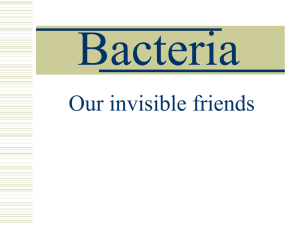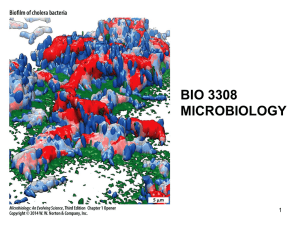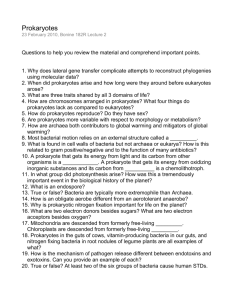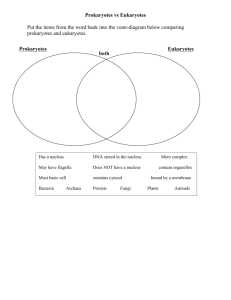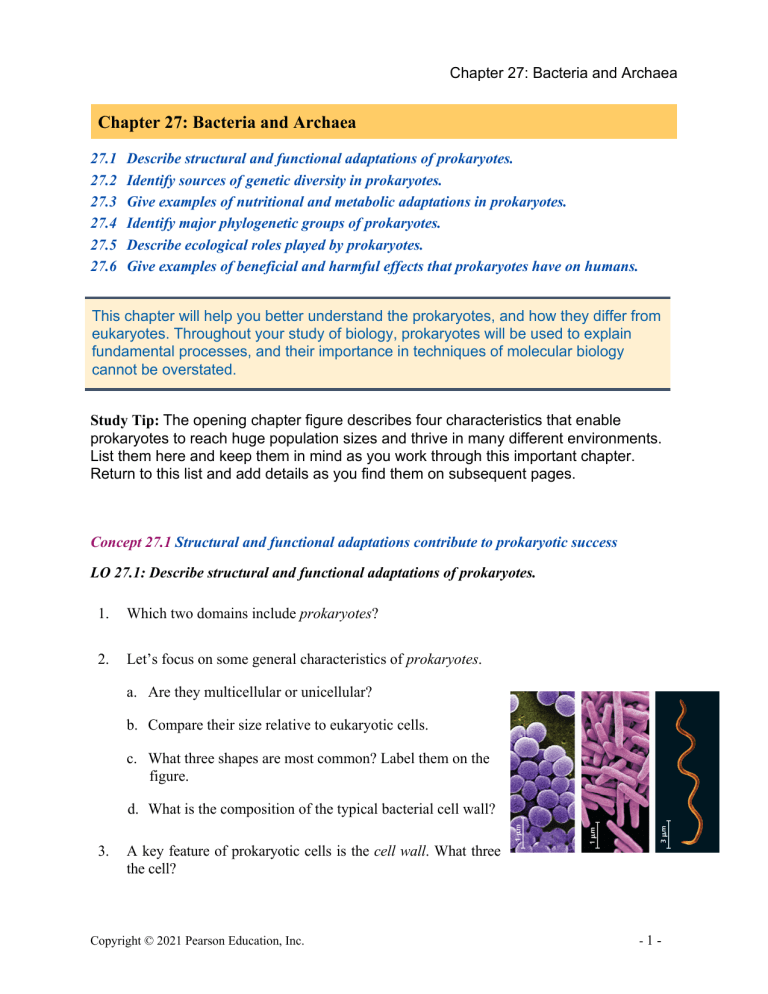
Chapter 27: Bacteria and Archaea Chapter 27: Bacteria and Archaea 27.1 27.2 27.3 27.4 27.5 27.6 Describe structural and functional adaptations of prokaryotes. Identify sources of genetic diversity in prokaryotes. Give examples of nutritional and metabolic adaptations in prokaryotes. Identify major phylogenetic groups of prokaryotes. Describe ecological roles played by prokaryotes. Give examples of beneficial and harmful effects that prokaryotes have on humans. This chapter will help you better understand the prokaryotes, and how they differ from eukaryotes. Throughout your study of biology, prokaryotes will be used to explain fundamental processes, and their importance in techniques of molecular biology cannot be overstated. Study Tip: The opening chapter figure describes four characteristics that enable prokaryotes to reach huge population sizes and thrive in many different environments. List them here and keep them in mind as you work through this important chapter. Return to this list and add details as you find them on subsequent pages. Concept 27.1 Structural and functional adaptations contribute to prokaryotic success LO 27.1: Describe structural and functional adaptations of prokaryotes. 1. Which two domains include prokaryotes? 2. Let’s focus on some general characteristics of prokaryotes. a. Are they multicellular or unicellular? b. Compare their size relative to eukaryotic cells. c. What three shapes are most common? Label them on the figure. d. What is the composition of the typical bacterial cell wall? 3. A key feature of prokaryotic cells is the cell wall. What three functions does it provide for the cell? Copyright © 2021 Pearson Education, Inc. -1- Chapter 27: Bacteria and Archaea 4. Quick review! What material composes the cell wall of plants? _______________ of fungi? _______________ 5. The cell walls of archaeans are different. They lack _______________ but contain _______________ and _______________. 6. Explain the difference between gram-positive and gram-negative bacteria. Consider why certain antibiotics are only effective on one type of bacteria or the other. 7. What is a bacterial capsule? What functions may it serve? 8. When conditions for survival are difficult, some species produce endospores. What are these? Can you name any species that form endospores? As a hint, consider what causes botulism or tetanus. 9. Many prokaryotes are capable of directional movement. What is this called? 10. What structure makes movement of bacteria possible? 11. What are the small, circular, self-replicating pieces of DNA found in bacteria called? 12. Compare prokaryotes to eukaryotes in terms of the following characteristics: Prokaryotes Eukaryotes Size Genome Membranes Location of genome Plasmids Ribosomes -2- Copyright © 2021 Pearson Education, Inc. Chapter 27: Bacteria and Archaea 13. Under ideal conditions, how quickly can E. coli divide? What conditions check prokaryotic reproduction? 14. What three key features allow prokaryotic populations to quickly consist of trillions of individuals? 15. Label the following structures of a typical prokaryote seen here: cell wall, sex pilus, circular chromosome, nucleoid region, ribosomes, flagella, capsule, and fimbriae. Sketch in and label two plasmids. For each structure, know the function. (Go to the end of the chapter, p. 591, for help with this figure.) Return now to the opening Study Tip and list several important bacterial adaptations. Concept 27.2 Rapid reproduction, mutation, and genetic recombination promote genetic diversity in prokaryotes LO 27.2: Identify sources of genetic diversity in prokaryotes. Copyright © 2021 Pearson Education, Inc. -3- Chapter 27: Bacteria and Archaea 16. As a result of large populations, rapid reproduction, and mutation, there is much potential for genetic diversity with bacterial populations. Think about the E. coli in your gut. The probability of a mutation in a specific gene in E. coli is one in ten million (1 × 10−7). Sounds like such a long shot how could it be a factor in evolution? However, every day you add 2 × 1010 new E. coli cells! How many bacteria per day will have a mutation in that one gene? Show your calculation here. 17. Although mutation is the major source of genetic variation in prokaryotes, genetic recombination introduces more variation. What is genetic recombination? 18. Complete the following chart to describe three ways genetic recombination may introduce variation. Source of Variation Description Transformation Transduction Conjugation 19. What is horizontal gene transfer? Which of the processes above might result in horizontal gene transfer in bacteria? 20. What occurs in bacterial conjugation? 21. What is a sex pilus? What is the F factor? How are the two related? 22. What is a bacterial cell designated as when: a. it has an F plasmid? b. it lacks an F plasmid? c. an F factor is incorporated into its chromosome? -4- Copyright © 2021 Pearson Education, Inc. Chapter 27: Bacteria and Archaea d. Which of the cells above function as donor cells in recombination? 23. When a mating bridge forms between an F+ cell and an F− cell the F plasmid is replicated and transferred to the F− cell, what is the status of the F− cell after the transfer? 24. What is an Hfr cell? How are Hfr cells created? 25. What are R plasmids and how do they contribute to the problem of antibiotic resistance? Study Tip This would be a good time to visit Mastering Biology and do the Figure Walkthrough for Figure 27.13 in your text. Concept 27.3 Diverse nutritional and metabolic adaptations have evolved in prokaryotes LO 27.3: Give examples of nutritional and metabolic adaptations in prokaryotes. 26. Prokaryotes can be placed in four groups according to their mode of nutrition, which is how they take in carbon and how they obtain energy. List each group in the following chart and summarize how each of them obtains energy. Place an * by the heterotrophs. (Table 27.1 will be helpful.) Mode of Nutrition 27. Energy Source Examples Compare the metabolic requirements of each group with respect to oxygen: obligate aerobes obligate anaerobes Copyright © 2021 Pearson Education, Inc. -5- Chapter 27: Bacteria and Archaea facultative anaerobes 28. To which of the previously noted groups do you think the bacterium Clostridium tetani, the causative agent of tetanus, belongs? 29. Biofilms form dental plaque and result in tooth decay. They can damage industrial and medical equipment and contaminate products. What are biofilms? 30. Explain how individual cells communicate and function within a biofilm. Concept 27.4 Prokaryotes have radiated into a diverse set of lineages LO 27.4: Identify major phylogenetic groups of prokaryotes. 31. In the 1970s, the use of small-subunit ribosomal RNA as a marker for evolutionary relationships changed our understanding of the taxonomy of prokaryotes. What new conclusions were formed? 32. What appears to be the role of horizontal gene transfer in the evolution of prokaryotes? 33. Figure 27.17 in your text highlights some of the key groups of bacteria. You will see that the 16,000 named species represent only a tiny portion of the actual number. For each group presented, select an important feature and example to help you recall something unique about the group. Bacterial Group -6- Important Feature/Example Copyright © 2021 Pearson Education, Inc. Chapter 27: Bacteria and Archaea 34. Compare the three domains of life in this chart by filling in either present or absent. Refer to Table 27.2. One row is done for you. A Comparison of the Three Domains of Life Characteristic Bacteria Archaea Eukarya Absent Present in some species Present Nuclear envelope Membrane-enclosed organelles Introns Histone proteins associated w/DNA Circular chromosome 35. Many archaea live on the edge and so are termed extremophiles. Where would you find these types of archaea? extreme halophiles extreme thermophiles The thermophiles are interesting because their DNA and enzymes are stable at high temperatures. DNA polymerases from thermophiles are important in the polymerase chain reaction (Chapter 20). 36. Pee-yoo! Methanogens are found in many habitats. What are some of these habitats? What do they all have in common? Copyright © 2021 Pearson Education, Inc. -7- Chapter 27: Bacteria and Archaea Concept 27.5 Prokaryotes play crucial roles in the biosphere LO 27.5: Describe ecological roles played by prokaryotes. 37. Define each of these terms, and give a specific example of the role that prokaryotes play in the terms marked with an asterisk (*): decomposers* symbiosis host symbiont mutualism* commensalism* parasitism* parasite pathogens* Concept 27.6 Prokaryotes have both beneficial and harmful effects on humans LO 27.6: Give examples of beneficial and harmful effects that prokaryotes have on humans. 38. The role of mutualistic bacteria in our intestines is an area of active research. Describe how mutualistic bacteria in the gut is important for human well-being. 39. There are many bacterial diseases. Make a list of six bad ones here and give as much information about each disease as you can find in your text. 40. Explain how a normally harmless symbiont of our gut, E. coli, can be the agent of serious food poisoning. (Tell the story of 0157:H7.) 41. What are antibiotics? Provide a detailed explanation for why they are becoming less effective. -8- Copyright © 2021 Pearson Education, Inc. Chapter 27: Bacteria and Archaea 42. Not all bacterial activity is negative. Humans employ bacteria for many diverse activities. Describe three human applications using prokaryotes in research and technology. Test Your Understanding, p. 592 Now you should be ready to test your knowledge. Place your answers here: 1. _________ 2. _________ 3. _________ 4. _________ 5. _________ 6. __________ Copyright © 2021 Pearson Education, Inc. -9-
